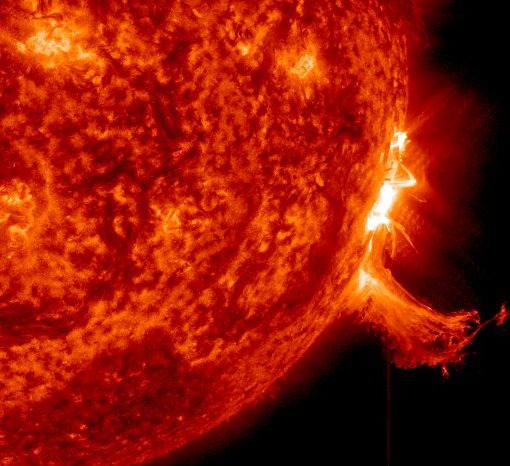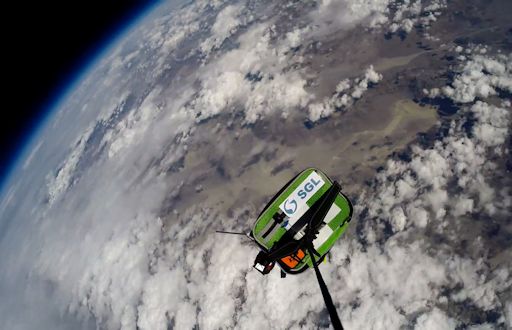On October 8th there will be a total eclipse of the Moon. Got clouds? No problem. The event will be broadcast live on the web by the Coca-Cola Science Center. | | |
NASA SPACECRAFT DETECTS SUPER X-FLARE: If you thought an X1-class solar flare was bad, how about an X100,000? NASA's Swift spacecraft has detected such a explosion. Fortunately for life on Earth, it did not come from the sun. The source of the super-flare was another star almost 60 light-years away: full story.
PARTING SHOT: Departing sunspot complex AR2172-AR2173 erupted on Oct. 2nd around 1915 UT, producing an M7-class solar flare. NASA Solar Dynamics Observatory photographed a massive plume of debris flying away from the blast site:

A flash of UV radiation from the flare ionized the top of Earth's atmosphere, briefly disturbing the normal propagation of shortwave and VLF radio signals on the dayside of Earth. Otherwise there should be few Earth-effects from this eruption. Perched on the sun's western limb, the instigating sunspot group is not facing our planet and most of the explosion's debris should sail wide of Earth.
There is a slim chance that a CME emerging from the blast site could deliver a glancing blow to Earth's magnetic field in a few days. More information about this possibility awaits the arrival of coronagraph data from SOHO and STEREO. Stay tuned. Solar flare alerts: text, voice
Realtime Aurora Photo Gallery
SPACE WEATHER BUOY RECOVERED: It only looks like a lunchbox. Pictured below is a Space Weather Buoy--an insulated capsule containing a cosmic ray detector, video cameras, GPS trackers, and other sensors. On Sept. 28th, it flew 115,000 feet above Earth's surface to check radiation levels in the stratosphere. This picture was taken at the apex of the flight:

In collaboration with Spaceweather.com, the students of Earth to Sky Calculus have been launching these buoys on a regular basis to study the effect of solar activity on Earth's upper atmosphere. Their latest flight has a sharply defined purpose: to find out if stratospheric radiation is rebounding from a "Forbush Decrease" earlier this month.
The story begins on Sept. 12th when a CME hit Earth head-on, sparking the strongest geomagnetic storm of the year. The students launched a Space Weather Buoy into the storm, expecting to measure an increase in energetic particles. Instead of more, however, they measured less. The CME swept away many of the cosmic rays around Earth and, as a result, radiation levels in the stratosphere dropped. This counterintuitive effect is called a "Forbush Decrease" after the 20th century physicist Scott Forbush who first described it.
Now that the CME is long gone, cosmic radiation levels around Earth should be returning to normal. But are they? The answer lies inside the payload, which a team recovered yesterday from a remote landing site in Death Valley National Park. Stay tuned.
Note: The students wish to thank Sander Geophysics for sponsoring this flight. (Note their logo in the upper right corner of the payload.) Their generous contribution of $500 paid for the helium and other supplies necessary to get this research off the ground.
Realtime Space Weather Photo Gallery
Realtime Comet Photo Gallery
Every night, a network of NASA all-sky cameras scans the skies above the United States for meteoritic fireballs. Automated software maintained by NASA's Meteoroid Environment Office calculates their orbits, velocity, penetration depth in Earth's atmosphere and many other characteristics. Daily results are presented here on Spaceweather.com.
On Oct. 2, 2014, the network reported 25 fireballs.
(24 sporadics, 1 Southern Taurid)

In this diagram of the inner solar system, all of the fireball orbits intersect at a single point--Earth. The orbits are color-coded by velocity, from slow (red) to fast (blue). [Larger image] [movies]
Potentially Hazardous Asteroids (
PHAs) are space rocks larger than approximately 100m that can come closer to Earth than 0.05 AU. None of the known PHAs is on a collision course with our planet, although astronomers are finding
new ones all the time.
On October 2, 2014 there were 1505 potentially hazardous asteroids.
Notes: LD means "Lunar Distance." 1 LD = 384,401 km, the distance between Earth and the Moon. 1 LD also equals 0.00256 AU. MAG is the visual magnitude of the asteroid on the date of closest approach. | | The official U.S. government space weather bureau |
| | The first place to look for information about sundogs, pillars, rainbows and related phenomena. |
| | Researchers call it a "Hubble for the sun." SDO is the most advanced solar observatory ever. |
| | 3D views of the sun from NASA's Solar and Terrestrial Relations Observatory |
| | Realtime and archival images of the Sun from SOHO. |
| | from the NOAA Space Environment Center |
| | the underlying science of space weather |

